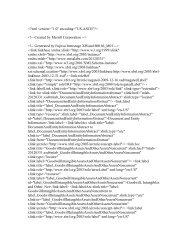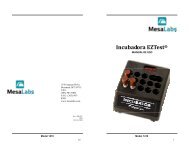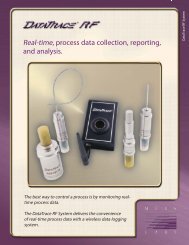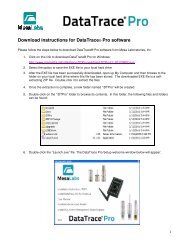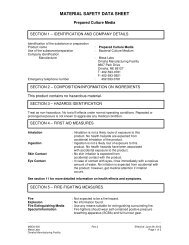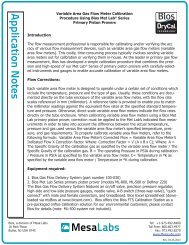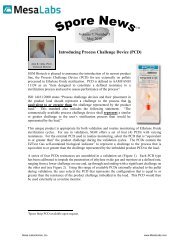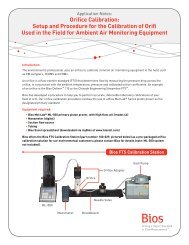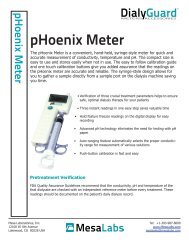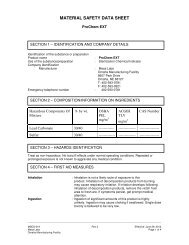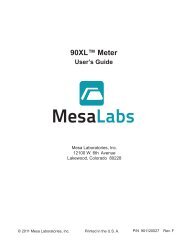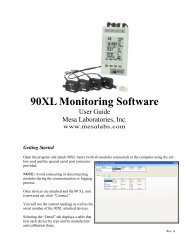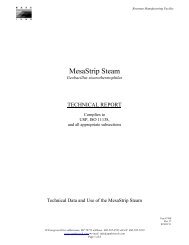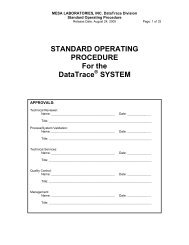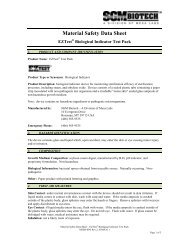Variable Area Flow Meter (Rotameter) Calibration - Mesa Labs
Variable Area Flow Meter (Rotameter) Calibration - Mesa Labs
Variable Area Flow Meter (Rotameter) Calibration - Mesa Labs
- No tags were found...
Create successful ePaper yourself
Turn your PDF publications into a flip-book with our unique Google optimized e-Paper software.
<strong>Variable</strong> <strong>Area</strong> Gas <strong>Flow</strong> <strong>Meter</strong> <strong>Calibration</strong><br />
Installation:<br />
Step 1<br />
Connect and/or verify all device connections. The Bios<br />
Gas <strong>Flow</strong> Delivery System comes with in-series, ¼” tubing<br />
connection of the on/off valve, pressure regulator,<br />
high-range pressure gauges, needle valve and A-B switch,<br />
as well as a “quick connect” with male/female connectors<br />
for connection of the on/off valve to the gas cylinder/<br />
compressed air<br />
Step 2<br />
Connect one end of the A-B switch to the inlet fitting of<br />
the variable area flow meter and the other end to the inlet<br />
fitting of your Met Lab<br />
Step 3<br />
Using the quick connect, connect the on/off valve to the<br />
gas cylinder/compressed air. Gas inlet pressure should<br />
be approximately 80 to100 psi<br />
Procedure:<br />
Step 1<br />
Close the needle valve, open the on/off valve and set<br />
the gas pressure by adjusting the pressure regulator<br />
to above 30 psi<br />
Step 2<br />
If the variable area flow meter contains a built-in needle<br />
valve, open its needle valve fully for unrestricted gas flow<br />
Step 3<br />
Turn on your Met Lab primary piston prover. Through<br />
its Setup menu, set your Met Lab’s pressure unit to ‘psi’<br />
and its flow readings to ‘Vol’ (Volumetric). For other flow<br />
measurement options (such as Continuous readings or the<br />
number of readings in the average), consult your Met Lab<br />
product manual<br />
Step 4<br />
Press your Met Lab’s Read button in order to record<br />
the ambient pressure and temperature<br />
Step 5<br />
Flip the A-B switch to the variable area flow meter and<br />
gradually begin to open the needle valve.<br />
Step 6<br />
Set the variable area flow meter’s flow at the desired<br />
level using the needle valve. The flow rate is indicated<br />
by the point on the printed scale where the float’s center<br />
stabilizes<br />
Step 7<br />
Wait one to two minutes for the float to stabilize.<br />
To ensure a particular flow point, flip the A-B switch back<br />
and forth a few times to check if the float returns to the<br />
previous scale point. If it needs adjustment, adjust the<br />
flow using the needle valve<br />
Step 8<br />
Record the low range pressure gauge’s pressure<br />
reading (in psia)<br />
Step 9<br />
If you are not using a direct scale variable area flow<br />
meter, record the reflected flow rate reading from<br />
the reference flow table against the floating point<br />
Step 10<br />
Refer to “<strong>Flow</strong> Corrections” in order to correct the<br />
variable area flow meter’s indicated flow for the<br />
operating temperature, pressure and the type of gas<br />
Step 11<br />
Flip the A-B switch to your Met Lab. Begin taking flow<br />
measurements with your Met Lab.<br />
Step 12<br />
Determine the full scale accuracy of the variable area<br />
flow meter using the following formula:<br />
% Accuracy = (Met Lab’s <strong>Flow</strong> Measurement - <strong>Variable</strong><br />
<strong>Area</strong> <strong>Flow</strong> <strong>Meter</strong>‘s corrected flow reading)*100 / <strong>Variable</strong><br />
<strong>Area</strong> <strong>Flow</strong> <strong>Meter</strong> Full Scale %<br />
Application Notes:<br />
• We recommend taking a minimum of ten flow measurements in an average. The more measurements in the average,<br />
the better the calibration results<br />
• Allow the Met Lab to stabilize before beginning a calibration<br />
• When calibrating a variable area flow meter, it’s best to use its specified calibration gas (calibrating with a surrogate<br />
gas can add greater uncertainty). If a surrogate must be used, we recommend using one with specific gravity similar<br />
to the gas the variable area flow meter is designed for



